Design Elements
We believe that communication is key to making your custom made jewelry truly reflect you
Custom Jewelry Choices
Jewelry jargon can be confusing. Even different jewelers will sometimes use different terms for the same custom design choices! These terms certainly apply to custom engagement rings, but also to any customized design. Here's your illustrated guide for sounding like a jewelry pro when you're having your next piece of jewelry designed
Gemstone Choices
Which gemstone shapes speak to you?
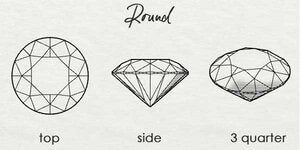
Round
A classic shape that's always the most popular for engagement rings.

Oval
Elegant ovals make the finger look longer when worn with the long axis in line with the finger.

Cushion
Cushion cuts can be elongated, have very curved sides or very straight sides with only the corners being rounded.

Square Cushion
Square cushions can have very curved sides or very straight sides with only the corners being rounded.

Emerald Cut
Emerald cuts have long, large facets compared to most other cuts. This makes them have fewer "sparkles" but the ones they have are big and intense.

Radiant
Radiants are the same outline as emerald cut but have many more and smaller facets.

Pear
Pears are having a moment. Setting them at an angle or pairing them with another shape are very on trend. Wear with care and set them in a way that protects the delicate point.
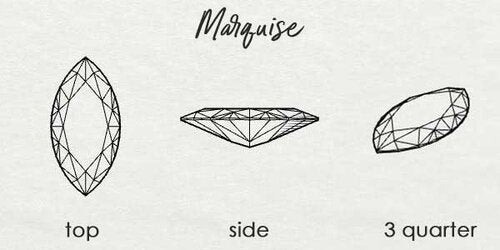
Marquise
Marquise shapes are experiencing a comeback recently with many celebrities sporting them in their engagement rings. Wear with care and set them in a way that protects the vulnerable points.

Princess
Square cuts are usually either step cut or princess cut. Princess cuts have lots more and smaller facets than step cuts which are more similar to the facets of emerald cuts. Wear with care and set them in a way that protects the vulnerable points.

Trillion
Trillions can either be the star as the main gem or the supporting cast as side or accent gems. Trillions have rounded sides as opposed to triangles which have straight sides.

Triangle
Most often seen as side gems flanking a larger center, triangles can also be the focal point of a design. Trillions have rounded sides as opposed to triangles which have straight sides. Wear with care and set them in a way that protects the vulnerable points.

Heart
A sentimental statement can be made with heart shapes either as a center gem or as side gems.

Cabochon (Cab)
Characterized by a smooth domed top, cabochons can be cut into almost any shape. While they may not be as sparkly as a faceted gem, depending on the type and clarity of the gem, they often have a lovely glow.
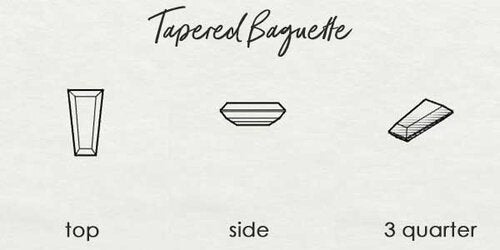
Tapered Baguette
Most often seen as accent gems, sometimes they can be the center of attention in the right setting.

Straight Baguette
Most often seen as accent gems, sometimes they can be the center of attention in the right setting.

Half Moon
Often seen flanking a center gem, the flat sides snuggle up close to many center gem shapes.
Setting Styles
These are the basic types of gemstone setting techniques, but there are endless variations of all of them.

Bezel
The bezel setting is one of the most secure and protective methods of setting diamonds and gemstones. It is held and protected by a thin strip of metal all the way around the gem.

Patial Bezel
Like the full bezel, the partial bezel setting is also very secure, but the openings allow you to see the sides of your diamond or gemstone.

Prong
Prong settings come in a huge variety of shapes and configurations. The one pictured here is a four prong basket setting. Basket settings can have more or fewer prongs.

Double Prong
This type of setting is often seen on cushion shaped gems because the double prong fits around the rounded corners more securely than a single prong.

Crown Prong
This regal looking variation on the prong setting is sometimes seen in vintage jewelry, although it has seen a surge in popularity in recent years.

"V" Prong
The pointy corners of princess cuts, marquises, and pear shapes tuck nicely into "V" prongs AKA chevrons. Those sharp points are often the most easily damaged parts of diamonds and gemstones and the "V" prongs offer extra protection.

Flush Set
Diamonds or gemstones are set level with the surrounding metal. This technique is best used with harder gems such as diamonds, sapphires, rubies.

Channel Set
Gems are secured by the channel walls. Channels can be straight or curvy.

Bead Set with Bright Cut
Small beads hold the gemstones between thin walls of metal that are cut with a shiny line. Those thin walls can also be milgrained, a technique that creates a decorative beaded edge.

Scoop & Split
This type of setting goes by many names such as micro pave and micro bead, but we use the term scoop and split which accurately describes the process of scooping out metal in strategic places and then splitting what's left to fold over the gems.

French Cut
The extra cut work under the gems adds a shiny light catching detail to the scoop and split setting.

Pave
Pave is a French word meaning pavement. The metal holding the gems almost disappears in the brilliance of the diamond covered surface.
Shank Profiles
These are the most commonly seen types of profiles or cross sections of both bands and shanks (the metal that goes around your finger in a ring). All of these profiles can be created in a variety of widths.

Half Round
The smooth dome of the half round profile is very comfortable to wear.

Comfort Fit
Refers to the domed inside contour of a ring. That rounded interior can be added to other profiles such as flat. This makes it easy to slide the ring on and off.

Flat
Tends to be used in more contemporary designs.

Knife Edge
Instead of a dome like the half round, the knife edge rises to a peak. But don't let the name fool you, it's not really sharp like the name implies.
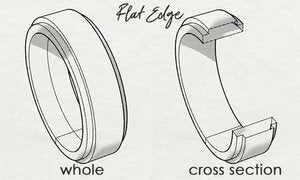
Flat edge
The addition of an edge that's a little lower in height than the rest of the ring can add extra design interest. It can also provide a place to add a decorative touch such as milgrain.

Concave
A super comfy and fun profile that can capture a spinning band or look great on its own.
Shank Shapes
The shank is the part of a ring that goes around your finger. The area at the top where the shank meets the main part of the ring is called the shoulders.

Low Rise
Where the shank meets the top of the ring are often called the shoulders. If the shoulders stay the same height or only rise a little, then it's a low-rise shank.

Cathedral
The shank swoops up toward the top of the ring, often with arms that branch off the main part of the shank.
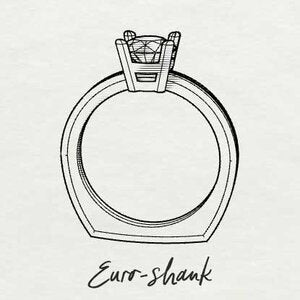
Euro
This variation can be added to lots of other shank shapes. Extra corners of metal at the bottom of the shank add weight to counterbalance a top-heavy ring.

Tapered
Traditionally, many rings are narrower at the bottom than at the top.

Reverse Taper
Like the tapered shape, there is variation in the width, but in this case, the widest area is at the bottom. This can also create some counterbalance to a ring prone to spinning.

Pinched
The classic tiffany style solitaire is a great example of how a shank can pinch in right next to the top of the ring.

Split
With arms that split off from the main part of the shank, this style makes a smooth but delicate looking transition between a narrow shank and a large gemstone for example.

Bypass
Refers to any shank shape that approaches the top of the ring from both sides but reversed from each other.
Wedding Set Fit Choices
The choice of how your engagement ring and engagement ring fit together is highly personal. The wedding set can often be soldered together to keep them from sliding out of alignment.
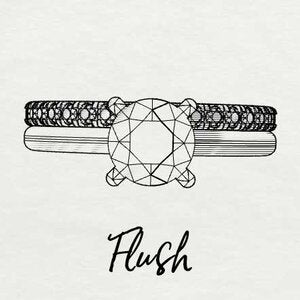
Flush
No space can be seen between the engagement ring and the wedding band.

Embrace the Gap
You either are totally cool with the gap or you're totally not. If you're in the not camp, you have options like the gentle curve or the fitted band.

Gentle Curve
Gracefully flows around the contours of your engagement ring without fitting into every nook.

Fitted
Fits fully around every contour of your engagement ring.
Contact Us
Ready to start your own custom jewelry project? Have questions? We're here for you!























